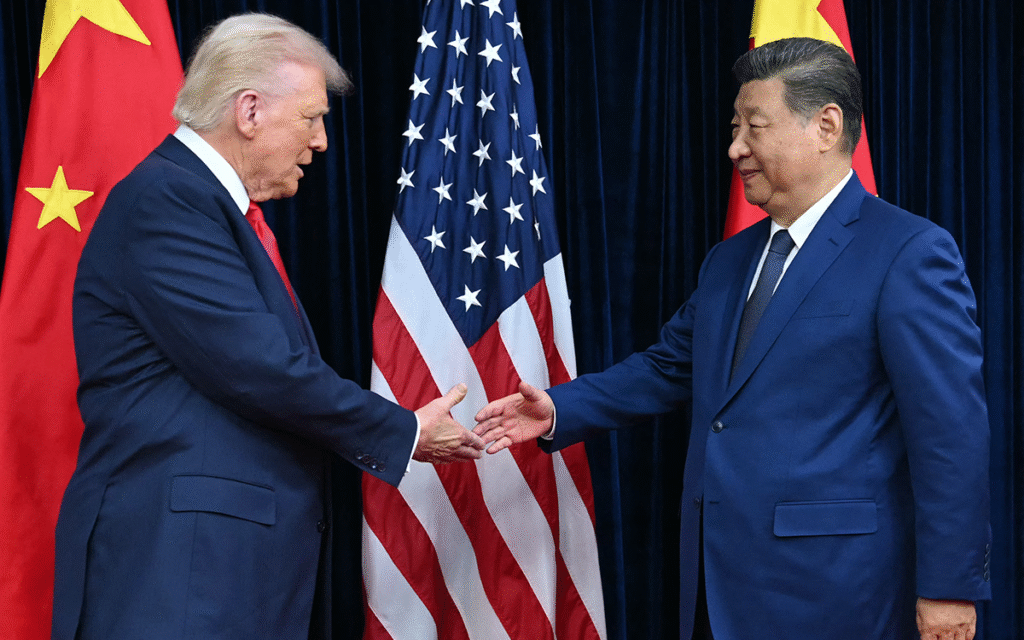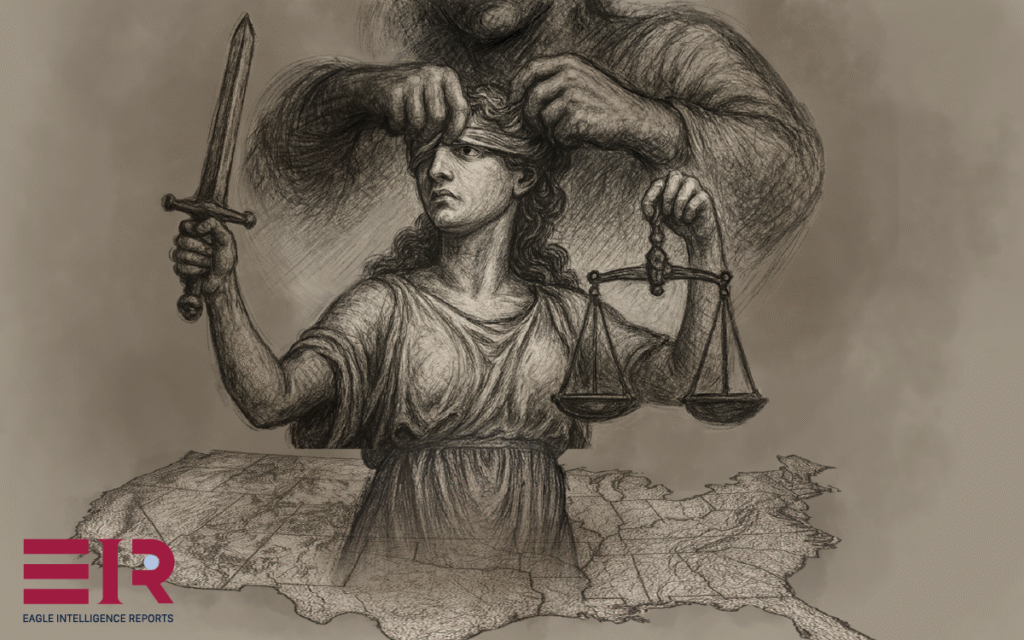Cryptocurrency didn’t grow in a straight line. It arrived in fits and starts, first as a curious experiment among a handful of tech enthusiasts, then as a fast-moving marketplace that pulled in millions of investors almost before anyone understood what it was becoming. In just a few years, it carved out a place of its own inside global finance. Yet despite all the attention and money flowing into it, the crypto world is still very young, operating with minimal oversight and sitting just outside the boundaries that govern traditional markets.
That gap matters. It is more than a technical detail; it is a fault line built into the foundation of the crypto world. And every so often, the volatility that defines this space doesn’t stay neatly contained within it. Instead, it spills outward, catching established markets off guard and reminding everyone that a system built on innovation and speed can still shake the very financial structures it once promised to reinvent.
President Donald Trump’s threat to slap 100 percent tariffs on China jolted cryptocurrency markets on October 10, causing Bitcoin, the market’s darling, to lose more than 10 percent of its value within minutes, and driving down the total market cap of crypto assets by billions of dollars. As stunned traders rushed to shore up accounts funded by borrowings and shaky collateral, algorithms automatically triggered liquidations of over $19 billion within 24 hours, wiping out the accounts of around 1.6 million traders. If the news of the day was bad, then the implications of such a rout for the future of a deregulated global economy are even worse. The crypto crash exposed vulnerabilities that could spark another economic catastrophe similar to the savings and loan scandal that cost American taxpayers $124 billion, or the infamous subprime housing crisis that culminated in the Great Recession (2007-2009), the worst economic downturn since the Great Depression (1929-1939).
The October crypto crash exposed vulnerabilities that could spark another economic catastrophe similar to the savings and loan scandal or the infamous subprime housing crisis
Fortunately, nothing like that happened in the rout that started on October 10, 2025. Crypto traders soon realized that the tariff threat was merely another bargaining chip in the US-China trade war. The worst of the whole crash ended within days, and things seemed to return to normal, but they really didn’t. Since then, crypto markets have remained fragile, with Bitcoin down more than 20 percent from its peak. Some eerily familiar signs of those larger economic crises also lurk in the shadows of the recent crash; vulnerabilities that suggest severe economic problems could surface unless the government takes corrective actions soon.
The Deregulation Thwarts Innovation Theory
The first and most ominous signal is the fever-pitch belief in deregulation among crypto enthusiasts. The philosophy that “the government is the problem”, a mantra eagerly promoted by President Ronald Reagan, is usually accompanied by impassioned pleas that regulators are thwarting innovation; an idea that free-market Americans love to praise as they ironically foist its fiascos on the rest of the world. The savings and loan scandal in the 1980s started as a drive for deregulation. The Reagan administration rammed legislation through Congress that deregulated savings and loan associations, known as S&Ls, businesses initially established to recycle local savings into mortgage loans for savers and borrowers living in the same neighborhood.
S&Ls at the time needed a shake-up; they’d been run by stodgy local bankers who had not changed their ways in decades. But the legislation embedding Reagan’s brand of innovation went too far. It removed controls on the interest rates on deposits, allowed S&Ls to invest in commercial real estate and engage in riskier loans, all while maintaining federal deposit insurance that protected depositors and weakened the powers of the regulators who scrutinized their operations. The result: the taxpayer became exposed to huge losses when the deregulated industry suffered a collapse. Investors and real estate entrepreneurs had acquired many savings and loan associations (S&Ls). They gave little attention to reserves, leaving the banks undercapitalized. Investors lured new deposits with higher interest rates on national financial markets, and booked riskier loans, sometimes to projects in which they had a vested interest. When it was all over, the S&L crisis cost American taxpayers an estimated $124 billion.

Regulators Ignored the Subprime Housing Debacle
A similar situation occurred in the subprime housing mortgage debacle several years later. Bankers identified a legitimate problem: prospective borrowers with poor credit histories struggled to obtain mortgage loans, hindering their pursuit of the American dream of homeownership. They collaborated with colleagues in the investment banking industry to develop new products and marketed them as innovative solutions. Bankers bundled thousands of higher-risk mortgages into something new: Mortgage-backed securities and Collateralized Debt Obligations (CDOs). They sliced bundles of mortgages into tranches, diversifying their risk profiles. Credit rating agencies, often ignoring their own conflict of interest, rated the new securities highly, and investment banks sold them to investors worldwide. The complexity was staggering, with layers of abstraction that made risk assessment nearly impossible.
In the case of CDOs, the phenomenon wasn’t deregulation; it was a lack of regulation. The Federal Reserve, ignoring advice of its own economists, declined to regulate mortgage lending standards. The Securities and Exchange Commission (SEC) also balked, exempting major investment banks from maintaining net capital requirements. Banking regulators allowed institutions to keep risky assets off their balance sheets. Then Federal Reserve Board Chairman Alan Greenspan, testifying before Congress after the crisis erupted, admitted to a “flaw” in his thinking, namely that the self-interests of leading firms under his scrutiny would protect shareholders and institutions. Economies around the world went into recession as the contagion from America spread. The government had to step in and prop up the banks that caused the problem, infuriating voters.
Crypto Enthusiasts Follow the Same Path
What happened in the crypto crash about a month ago shows that the crypto industry and the government are galloping down the same path as their predecessors; only this time, the inevitable impact will be felt far more widely due to the global nature of the crypto business and its 24/7 trading regimen. Crypto is the Wild West of finance, a complex and obtuse market, far more challenging to understand than CDOs. Crypto advocates are developing the industry within a regulatory vacuum created by gaps in existing laws and new frameworks that struggle to address the issues involved. The lack of standards and scrutiny leaves everyone on crypto trading platforms rife with risk.
Crypto advocates are developing the industry within a regulatory vacuum created by gaps in existing laws and new frameworks that struggle to address the issues involved
As usual, there’s some truth to the crypto gospel. The evolving market has an innovative flair. Bitcoin’s launch in 2009 marked the introduction of a novel technology featuring a transformative blockchain ledger that could benefit the public. Unfortunately, thousands of cryptocurrencies and crypto wannabes proliferated in Bitcoin’s wake, operating with minimal regulatory oversight and luring crypto deposits by offering rates far higher than those of traditional banks. Regulatory oversight is almost non-existent. At this point, American taxpayers don’t seem as vulnerable as they were in the S&L or the subprime mortgage crises. But they didn’t seem exposed at the outset of those fiascos, either.
The crypto industry makes the same pleas for deregulation as their forebearers, vociferously opposing regulation, arguing that innovation requires freedom and that decentralized markets make traditional oversight obsolete. They have powerful advocates in the White House, including President Trump, whose family and friends are heavily involved in World Liberty Financial, a crypto business. The president signed an executive order in August that allows 401(k) investors access to alternative assets, including cryptocurrencies. And he has appointed David Sacks, a prominent Silicon Valley entrepreneur and advocate for deregulation, as the government’s crypto and artificial intelligence czar. The October crash suggests that their soothing words about obsolete regulations are wrong, though.
Crypto Markets “All Gas and No Brakes”
All efficient markets require integrated pricing, enabling investors and the public to see consistent and credible prices. In contrast, crypto platforms have no such requirement, creating an atmosphere where allegations of market manipulation can thrive.
Molly White, who runs Citation Needed, one of the few independent publications that credibly covers the crypto industry, reported that someone made $150 million on a well-placed short sell during the October crash, raising suspicions that an investor had inside information. “In traditional markets,” she wrote, “a $150 million profit on well-time shorts ahead of a presidential announcement might trigger inquiries from the SEC, the Commodity Futures Trading Commission (CFTC), or the Justice Department. But in crypto, it’s not even clear which agency, if any, would have authority to investigate crypto trades.”
Traditional markets also have circuit breakers and trading halts that can pause cascading liquidations triggered by unreliable price quotes and excessive debt collateralized by other volatile cryptocurrencies. The crisis revealed that banks could liquidate crypto traders’ positions before they even realized trouble was on the horizon. As White wrote, “Crypto markets are all gas and no brakes.”
Crypto Liquidation Cascades Breed Chaos
The most serious fault exposed by the October crash is the phenomenon of interconnected liquidation cascades. These occur when an external event, such as Trump’s post, triggers a widespread decline in cryptocurrency prices. Traders who use borrowed money to acquire crypto assets face margin calls, or liquidation systems driven by algorithms that automatically sell their crypto to recover a lender’s funds. Mass liquidation then overwhelms potential buyers, which puts further downward pressure on prices. Soon, price declines in Bitcoin prompt the sale of other related assets, exchanges face stress, highly leveraged funds default, and each wave of selling triggers new liquidations. Such events played out in hours during the October crash. Market depth collapsed by more than 80 percent across major exchanges within minutes, and the bank’s algorithms liquidated positions worth $2.1 billion.
The crash revealed the extent of some troubling connections between the cryptocurrency markets and the global financial system. Capital flows ignore national boundaries. The October crash illustrates how a sudden cryptocurrency collapse can trigger cascading effects through equity markets in Europe and Asia, where investors have increased their allocation to digital assets. Sudden market shocks pose serious challenges to central banks. Crypto markets operate 24 hours a day, 7 days a week, but the US Federal Reserve designs monetary policy for markets that shut down at the end of each trading day. When panic selling occurs during times when traditional markets are closed, as it did in October, such vacuums leave central bankers with few options.
Capital flows ignore national boundaries. The October crash illustrates how a sudden cryptocurrency collapse can trigger cascading effects through equity markets in Europe and Asia
The October Rout Hit Global Markets Quickly
The absence of the discipline normally imposed by sensible government regulation exposed faults that make crypto a prime candidate for a much wider collapse. The October crypto market rout quickly spread to global markets. European institutional investors with substantial exposure to US-listed crypto ETFs and derivatives experienced heavy selling, triggering margin calls and their own liquidation spirals. Asian exchanges with their higher leverage ratios and different operating hours opened up to a deteriorating situation. They quickly hit liquidation thresholds, diluting the US financial system’s ability to contain a panic.
Luckily, the crypto markets avoided such a fiasco as sharp price declines lured investors seeking risk-based profits to “buy the dip,” containing the market impact. President Trump also helped when he walked back his tariff threats. However, the signs of vulnerability persist. Regulators are unlikely to take any action, and the industry shows no signs of remorse. In fact, crypto exchanges continue to offer investors extraordinary levels of leverage, and crypto advocates continue to press for greater integration with traditional financial markets.
Risk of Contagion Grows with Foreign Banks
Such a marriage risks a messy divorce. Currently, regulators insist that cryptocurrency exposure poses limited systemic risk to traditional finance, where stocks and bonds trade on highly regulated markets. But the financial landscape is evolving rapidly, particularly through European and Asian banks. As crypto advocates become more effective in integrating with traditional markets, the risk of contagion grows, where trouble in one market spreads quickly to others.
Aware of this peril, regulators in Europe and Asia are more sensitive to crypto investments than their American counterparts. Indeed, European authorities created some of the world’s most comprehensive oversight, effective as of January 1, 2025. The European Union, in late 2024, enacted the first regulatory framework for crypto assets, limiting direct investments to ensure minimal credit exposure. Nevertheless, savvy investors can devise workarounds by capitalizing on indirect channels to invest in crypto ETFs, structured products, and cryptocurrency funds. Although the outright refusal of banks to deal in crypto is more severe in Europe, experts now estimate nearly 10 percent of households in large euro-area countries own some form of crypto, and some 63 banks offer crypto services.
In Asia, cryptocurrency investment is far more aggressive. Between 2018 and 2024, the Asian cryptocurrency sector achieved a market capitalization of $3.3 trillion, representing a 24-fold increase, making the region a hub of global cryptocurrency activity. Asian regulators have also placed strict limits on corporate digital asset holdings. Still, they adopt a more flexible approach to regulated investment vehicles, such as the offices of wealthy families that have become significant players in the crypto market. The existing regulations reflect concerns that troubles with one large crypto investor can have a ripple effect on others.

Europe, Asia Investors Heavily Exposed to US Stocks
A larger problem is that troubles in the crypto world could impact traditional stock and bond markets as the two become more intertwined, a marriage that crypto investors desire. European and Asian institutional investors face significant exposure to US stocks, particularly through global equity allocations that track the MSCI, which is like the Dow Jones index for international stocks. Since the MSCI index comprises more than 70 percent of US stocks, its close tracking by European and Asian investors suggests that exposure to US equities is substantial. The Economist estimates foreign exposure to US stocks at $18 trillion, implying that market contagion could occur if another crypto crash spreads to US equities, potentially triggering a domino effect that could prove challenging to contain globally.
Geopolitics adds further complexity to the situation. China has banned cryptocurrency trading. Nevertheless, the nation continues to develop its digital yuan as an alternative, viewing crypto as a threat to its capital controls. China views crypto vulnerabilities as a threat to Western financial stability. India takes a more cautious approach, slapping crypto capital gains with a stiff tax while it explores its own alternative central bank digital currency. Both nations view America’s embrace of cryptocurrency as a harbinger of instability, making their digital currencies attractive alternatives and thereby thrusting crypto into the strategic competition among significant powers vying to shape the future of global finance and power.
China views crypto vulnerabilities as a threat to Western financial stability. India takes a more cautious approach, slapping crypto capital gains with a stiff tax
In the end, the turmoil set off in October did not topple the financial system. What it did was remind everyone, perhaps more clearly than anything in recent years, how little it takes to make global markets uneasy. People who believe strongly in crypto keep saying that a new financial era is already forming. They may have a point, and parts of that future are clearly taking shape. But what also seems hard to ignore is a recurring lesson from past crises: when money moves through markets that rely on opaque structures and heavy borrowing, trouble usually shows up somewhere down the line. Whether crypto settles into a stable place in global finance or ends up lighting the fuse of the next major crisis will depend on whether regulators act with some foresight now, not after the damage has begun.














